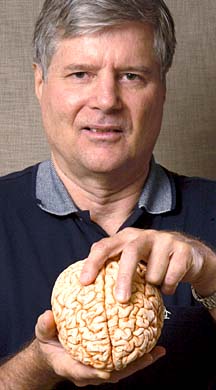
Hand testing reveals
left-right brain styleThe study covers more than 1,000
faculty members and students at UH
University of Hawaii-Manoa astronomers and architects tend to be right-brain-oriented while particle physicists and microbiologists are left-brainers, according to a study of more than 1,000 UH-Manoa students and faculty.
COURTESY BRUCE MORTON
Bruce Morton is a right-brainer who balances research with hang-gliding and snow-boarding.
The paper by Bruce Morton, UH professor emeritus of biochemistry and biophysics, was published in the August issue of the journal Brain and Cognition. It is the sixth in a series of studies he began six years ago to debunk the discrediting of hemisphericity by some psychiatrists and psychologists.
The brain has right and left hemispheres, and "hemisphericity" generally refers to the predominance of one side in influencing a person's thinking and learning style.
Generally, Morton said, right-brainers are bottom-up, big-picture people, high in intensity. Left-brainers are top-down people, detailed, impatient, more abstract and unemotional, he said. But right-brainers are found in the left-brain group, and vice versa, he noted.
Attempts to determine whether a person is a right- or left-brainer have been hampered by inadequate methods of measurement, disagreement about the meaning of hemisphericity and "lack of certainty that the phenomenon even exists," Morton said.
Investigating hemisphericity after retiring from UH in 1995, he developed seven independent measures of right- or left-brain orientation that "correlated significantly with each other," he said.
"It was unfunded work," he added, "and kind of exciting to me, discovering on my own initiative what would (usually) take millions of dollars in grants."
In his latest study, Morton used a simple "best hand test," which takes participants a few minutes to determine whether they're right- or left-brain oriented.
They were asked to mark the center of 20 lines on two identical sheets of paper, one for their right hand, the other for their left hand.
They also were asked to answer a few questions, such as whether they were right- or left-handed, if they did anything better with their left hand or foot and if they pointed a pen away, across or toward themselves when writing.
Morton said those are important factors, but whether a person is right- or left-brain-oriented isn't related to being right- or left-handed. Surprisingly, many right-handed people were more accurate marking the center with their left hand, he said.
He tested 402 entry-level UH students in lower-division courses and found they were about equal left- and right-brainers.
But differences increased when he tested students in more specialized upper-division classes and graduate courses. Morton found even more pronounced differences among faculty members of 15 professions and subspecialties, reflecting "a progressive sorting," he said.
Only 29 percent of UH-Manoa astronomers tested were left-brain-oriented, while 73 percent of particle physicists were left-brainers "in keeping with the popular 'forest vs. trees' right and left orientation," Morton said.
He said another stereotype, that a right-brain person lacks quantitative ability, appeared to be contradicted by the majority of right-brain-oriented astronomers or architects whose work required quantitative thinking.
Also disputing a stereotype, he found 63 percent of art department professors were left-brain-oriented. However, they included 10 specialists in art history, printmaking and other technical skills, he noted.
About half of the remaining professors who created more traditional works of art were predominantly right-brain-oriented, he said.
Dr. Robert Marvit, Honolulu psychiatrist, said Morton's test "is fine for looking at right- and left-brain preferences. The question then is the significance of that as it relates to personality and behavioral characteristics of those who have these preferences."
Morton said he has taken the next steps, and the results are pending publication.
He said when he came to UH in 1969 with a doctorate from the University of Wisconsin and postdoctoral fellowships at the Massachusetts Institute of Technology and Harvard Medical School, he chose to do something that would be "significant for the human condition."
He turned to the brain because it is the most complex and least understood organ, and ended up educating himself as a neuroscientist, he said.
A right-brainer who balances research with hang-gliding, wind-surfing and snow-boarding, Morton said he frequently gets calls from people wanting to take the test to see if they're right- or left-brain-oriented, but his method must be used in a group for accuracy.
At least four independent tests are necessary to obtain an accurate assessment for an individual, he said.

